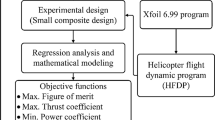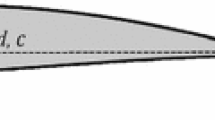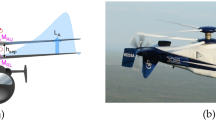Abstract
In classical composite helicopter rotor blade production, a small flat tab must be formed along the entire trailing edge, in order to enable proper merging of the upper and the lower surface plies during manufacturing. By this, the original airfoil shape is altered. Such fixed tabs have been added in a range of possible angular positions to several existing asymmetrical helicopter airfoils, and their capability to change the moment coefficient about the aerodynamic center of the airfoils was initially analyzed. Although usual tabs are proportionally small, angular domains in which they do not remarkably change the required nearly zero aerodynamic moment, were quantified as very narrow. In the next stage, an algorithm has been defined and implemented: (a) for the determination of optimum angular tab positions for several asymmetrical airfoils, that satisfy the moment requirement (for such airfoils optimum tab direction cannot be known in advance), and (b) for the reduction of the influence of eventual inherent numerical errors of applied software to a minimum. The accuracy of this algorithm has been verified on a symmetrical airfoil, for which the optimum tab position is readily known. In the next step, the tab influence on other aerodynamic airfoil characteristics, and the influence on flight performance of a light helicopter from an on-going project, has been analyzed. Several possible tab design concepts were defined, and some characteristic aspects of their implementation were considered. At the level of preliminary helicopter performance calculations, the influence of the two general outcomes of the tab designs were analyzed, one that preserves initial relative airfoil thickness, and another which leads to its reduction. In the first case, the influence of the slight increase of drag coefficient was taken into account, while in the second one, the decrease of drag coefficient, accompanied with necessary additional strengthening and added blade mass was considered. In both cases applied modifications proved to have moderate direct influence on helicopter flight performance, compared with a hypothetic case that the original airfoil without tab could have been used instead. General conclusions have imposed the need for very careful approach in tab design for asymmetrical airfoils, which must be primarily focused on the tab’s potential remarkable influence on the aerodynamic moment.
Similar content being viewed by others
References
Abbot I.H. and Von Doenhoff A.E. (1959). Theory of wing sections, including a summary of airfoil data. Dover, New York
Kostić I. (2005). Some practical issues in computational design of airfoils for the helicopter main rotor blades. Theor. Appl. Mech. 31(3–4): 271–305
Kostić I. (2003). Improved numerical calculation of the airfoil transonic drag applied within a zonal flowfield modeling concept. FME Trans. 31(2): 61–68
Kostić, I.: TRANPRO—airfoil design, optimization and analysis program, 1st edn. 1997, Aeronautical Department, Faculty of Mechanical Engineering, Belgrade (2002)
Kostić, I.: An improved method for the design and calculation of aerodynamic characteristics of airfoils with the dominant turbulent boundary layer at subsonic and lower transonic speeds, 21st Internat. Council of Aerospace Science Congress, ICAS-98-2.9.4, Melbourne (1998)
Lednicer, D.: Incomplete guide to airfoil usage (database currently under development), http://www.amber.aae.uiuc.edu/~m-selig/ads/aircraft.html, Analytical Methods, Redmond (2004)
Leishman J.G. (2000). Principles of helicopter aerodynamics. Cambridge University Press, Cambridge, New York
Schlichting H. and Truckenbrodt E. (1997). Aerodynamics of the airplane (engl. translat. by H. Ramm). McGraw-Hill, New York
Seddon J. (1990). Basic helicopter aerodynamics. BSP Professional Books, Oxford
Stivers, L.S., Rice, F.J.: Aerodynamic characteristics of four NACA airfoil sections designed for helicopter rotor blades, NACA RB No. L5K02 (1946)
University of Illinois (2005) Airfoil coordinates database Ver. 2.0, http://www.aae.uiuc.edu/m-selig/ads/coord_database. html#N
Young A.D. (1989). Boundary layers. BSP Professional Books, Oxford
Author information
Authors and Affiliations
Corresponding author
Rights and permissions
About this article
Cite this article
Kostić, I. Numerical evaluation of the aerodynamic influence of the helicopter composite blade trailing edge tabs. Arch Appl Mech 77, 893–909 (2007). https://doi.org/10.1007/s00419-007-0133-1
Received:
Accepted:
Published:
Issue Date:
DOI: https://doi.org/10.1007/s00419-007-0133-1




